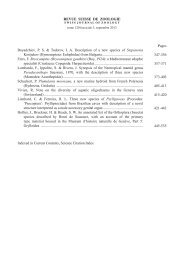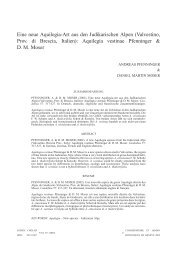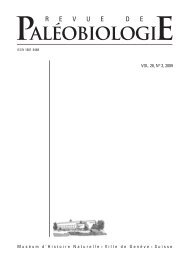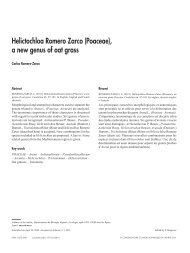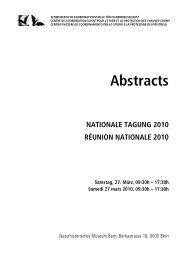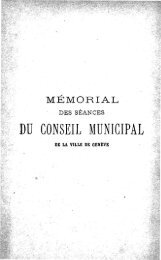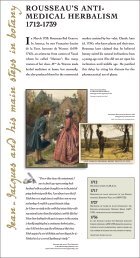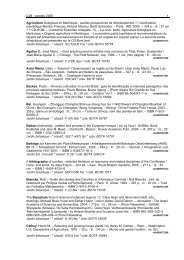Full text article - Ville de Genève
Full text article - Ville de Genève
Full text article - Ville de Genève
You also want an ePaper? Increase the reach of your titles
YUMPU automatically turns print PDFs into web optimized ePapers that Google loves.
The formation of plicae in capsules of mosses of the or<strong>de</strong>rBryales, with a focus on the genus Grimmia Hedw.EVA MAIERABSTRACTMAIER, E. (2004). The formation of plicae in capsules of mosses of the or<strong>de</strong>r Bryales,with a focus on the genus Grimmia Hedw. Candollea 59: 51-63. In English, English, French andGerman abstracts.The structure of moss capsules and the formation of plicae in selected species of the genusGrimmia Hedw. and from further species of different moss families in the or<strong>de</strong>r Bryales are<strong>de</strong>scribed. These <strong>de</strong>scriptions are accompanied by drawings of transverse sections of capsulesin immature and mature states. The study shows two different pathways of <strong>de</strong>velopment ofplicae in capsules : 1) plications that originate in the capsule wall tissue (eg. Grimmia subg.Rhabdogrimmia Limpr.); 2) plications that have their origin in the constitution of the exothecialcells. The differences and similarities between the two <strong>de</strong>velopmental patterns and the variouscapsule sections are commented upon here.RÉSUMÉMAIER, E. (2004). La formation <strong>de</strong> plis dans les capsules <strong>de</strong> mousses <strong>de</strong> l’ordre <strong>de</strong>s Bryales, plusparticulièrement dans le genre Grimmia Hedw. Candollea 59: 51-63. En anglais, résumés en anglais,français et allemand.La structure <strong>de</strong>s capsules et le développement <strong>de</strong> plis au sein d’espèces sélectionnées dans le genreGrimmia Hedw. ainsi que dans d’autres espèces <strong>de</strong> différentes familles <strong>de</strong> mousses <strong>de</strong> l’ordre <strong>de</strong>sBryales sont décrits. Des <strong>de</strong>ssins <strong>de</strong> coupes transversales <strong>de</strong> capsules à l’état immature et matureillustrent les <strong>de</strong>scriptions. L’étu<strong>de</strong> met en évi<strong>de</strong>nce <strong>de</strong>ux concepts différents du développement <strong>de</strong>splis: 1) la formation <strong>de</strong>s plis a son origine dans la structure du tissu capsulaire (p. ex. dans Grimmiasubg. Rhabdogrimmia Limpr.); 2) la formation <strong>de</strong>s plis a son origine dans la constitution cellulaire<strong>de</strong> l’exothecium. Les différences et similitu<strong>de</strong>s sont commentées.ZUSAMMENFASSUNGMAIER, E. (2004). Die Faltenbildung in Kapseln von Laubmoosen <strong>de</strong>r Ordnung Bryales,insbeson<strong>de</strong>re <strong>de</strong>r Gattung Grimmia Hedw. Candollea 59: 51-63. In Englisch, englische, französischeund <strong>de</strong>utsche Zusammenfassungen.Der Bau von Laubmooskapseln und die Entwicklung von Falten in ausgewählten Arten <strong>de</strong>r GattungGrimmia Hedw. und weiterer Arten aus verschie<strong>de</strong>nen Laubmoosfamilien <strong>de</strong>r Ordnung Bryaleswer<strong>de</strong>n beschrieben. Zeichnungen von Kapselquerschnitten im unreifen und im reifen Zustandveranschaulichen die Beschreibungen. Die Untersuchung belegt zwei verschie<strong>de</strong>ne Möglichkeiten<strong>de</strong>r Faltenbildung : 1) Die Faltenbildung entsteht im Kapselgewebe (z. B. Grimmia subg.Rhabdogrimmia Limpr.) ; 2) Die Faltenbildung hat ihren Ursprung in <strong>de</strong>r Konstitution <strong>de</strong>rExotheziumzellen. Unterschie<strong>de</strong> und Ähnlichkeiten wer<strong>de</strong>n besprochen.KEY-WORDS: BRYALES – Grimmia – Grimmia subg. Rhabdogrimmia – Species concept –Capsule structure – Development of plicaeCODEN: CNDLAR CONSERVATOIRE ET JARDIN59(1) 51 (2004) ©ISSN: 0373-2967 BOTANIQUES DE GENÈVE 2004
52CANDOLLEA 59, 2004IntroductionSpecies of the genus Grimmia Hedw. are <strong>de</strong>fined by the primary diagnostic charactersof haplolepidous peristomes with sixteen teeth separated down to the insertion (LIMPRICHT, 1885-1889: 694) and costae with ventral gui<strong>de</strong> cells (LIMPRICHT, 1885-1889: 722). The sporophyteshave either smooth-walled or plicate capsules. The species with smooth-walled capsules aremembers of the genus Grimmia s. str., and those with plicate capsules belong to the subgenus RhabdogrimmiaLimpr. of the genus Grimmia (LIMPRICHT, 1885-1889: 759). Characters correlatedwith plicate capsules (section Rhabdogrimmia) are bent setae and mitrate calyptrae, althoughbent setae and mitrate calyptrae appear sporadically in the genus Grimmia s. str. in variouscombinations too. The name Rhabdogrimmia originated from the Greek «rhabdos», stick or rod,a reference to the vertically striate capsule wall.Plicate capsules also appear within other families of the Bryales as they are given in VITT(1984: 744), for example members of the Ditrichaceae, Rhabdoweisiaceae, Orthotrichaceae, andBrachytheciaceae. In haplolepidous and diplolepidous mosses both plicate and smooth capsulesare produced. In spite of differences in capsule wall form, smooth or plicate, the architecture of atypical moss capsule follows the same fundamental plan (SCHIMPER, 1848; LIMPRICHT, 1885-1889: 44). CAVERS (1911: 27) states that «the Bryales, by far the largest group of Bryophyta,present extraordinary uniformity in the early <strong>de</strong>velopment of the sporogonium».The plicae of the capsules in the diverse families presented here (see Table 1. for taxonomicand species listing) seem to be more or less uniform. However, upon anatomical investigation theplicae perceptible in the species of the subgenus Rhabdogrimmia appeared to <strong>de</strong>viate from the morenormal cell pattern. LIMPRICHT (1885-1889; 1890-1895) had already observed this differencein plicae as seen by his selection of different terms for the <strong>de</strong>scription of plicae in moss capsules.The terms «Längsrippen» or «Rippen», translated as «ribs» (by the present author), is reserved to<strong>de</strong>scribe the plications of the Grimmia subg. Rhabdogrimmia capsules. The capsules of membersof other genera with plicate capsules are <strong>de</strong>scribed as having «gestreifte» or «gefurchte Kapseln»,translated as «striped» or «furrowed capsules» (by the present author).The aim of the study is to aid in the un<strong>de</strong>rstanding of the origins and <strong>de</strong>velopment of theplicae in moss capsules. To achieve this, the architecture of capsules and the capsule wall regionof selected species of the or<strong>de</strong>r Bryales are investigated.Materials and methodsMaterialsThe species selected for the study were those known to produce plicate capsules. They werechosen from four of the seven «phylogenetically significant lineages presented in a synthetically<strong>de</strong>rived cladogram» given by VITT (1984: 716). These lineages are the Orthotrichineae, theHypnineae, the Encalyptineae with the Pottiineae, and the Dicranineae including the Seligerineaeand the Grimmiineae. The species are arranged following the classification of subor<strong>de</strong>rs in the or<strong>de</strong>rBryales (Arthrodontae) given in VITT (1984: 744) with the exception of Amphidium mougeotii(Bruch & Schimp.) Schimp. (see Table 1). VITT (1984: 753) placed the species in the Rhabdoweisiaceae.In LIMPRICHT (1890-1895: 3) however, in the opus cited by VITT (1984),A. mougeotii was placed in the Orthotrichaceae, an opinion adopted here. The most recentpresentation of the systematic position of Amphidium is treated in LA FARGE & al. (2000: 270).
FORMATION OF PLICAE IN CAPSULES OF MOSSES OF THE ORDER BRYALES 53Table 1. Presentation of species used in the investigation, according to VITT (1984).Subor<strong>de</strong>r Family Genus and speciesOrthotrichineae Orthotrichaceae Amphidium mougeotii (Bruch & Schimp.) Schimp.Orthotrichum anomalum Hedw.Orthotrichum stramineum Brid.Hypnineae Brachytheciaceae Eurhynchium striatum (Hedw.) Schimp.Encalyptineae Encalyptaceae Encalypta rhaptocarpa Schwägr.Pottiineae Pottiaceae Tortula subulata Hedw.Dicranineae Dicranaceae Cynodontium strumiferum (Hedw.) Lindb.Oreas martiana (Hoppe & Hornsch.) Brid.Leucobryaceae Leucobryum glaucum (Hedw.) Ångstr.Rhabdoweisiaceae Rhabdoweisia fugax (Hedw.) Bruch & Schimp.Ditrichaceae Ceratodon purpureus (Hedw.) Brid.Seligeriineae Seligeriaceae Brachydontium tricho<strong>de</strong>s (F. Weber) Mil<strong>de</strong>Grimmiineae Grimmiaceae Grimmia Hedw. s. str.Grimmia elongata Kaulf.Grimmia laevigata (Brid.) Brid.Grimmia ovalis (Hedw.) Lindb.The nomenclature follows CORLEY & al. (1981).NOTE: the author is informed of the work of OCHYRA & al. (2003).Grimmia subg. Rhabdogrimmia Limpr.Grimmia consobrina Müll. Hal.Grimmia dissimulata E. MaierGrimmia elatior Bals.-Criv. & De Not.Grimmia meridionalis (Müll. Hal.) E. MaierGrimmia pulvinata (Hedw.) Sm.MethodsThe <strong>de</strong>velopmental pattern of a moss capsule from the green stage to the spore dispersingstage are based on SCHIMPER’s (1848) meticulous anatomical and morphological studies ofcapsule ontogeny. The transformation that happens in a moss capsule as it matures can be tracedup to the states of necrosis and maturation, as indicated by the change in capsule colour from <strong>de</strong>epgreen to a fa<strong>de</strong>d yellow-green that appears first in the annulus region. In the necrosis phase thetissues constituting structures in the capsule are rapidly <strong>de</strong>stroyed by the <strong>de</strong>siccation of thecolumella, the rupture of the archesporium, and the collapse of the endothecium. It is just beforethe necrosis stage that the capsule is in its green stage (KREULEN, 1972a: 65) and pure green incolour. This green stage should be selected for the study of the capsule architecture, an observationconfirmed by KREULEN (1972a: 65). The colour of the capsule, as a whole, changes with theproceeding maturation process and can be used as a gui<strong>de</strong> to the state of maturation of the capsule.The green capsule is humidified with a minimum of water to adhere it to the sli<strong>de</strong>. The mostinstructive and comparable transverse sections are achieved from below the middle of the capsule.The immature capsule is cut free hand with a sharp razor-bla<strong>de</strong> directly on the sli<strong>de</strong>. The sectionsare carefully heated on the sli<strong>de</strong> in some drops of KOH 1.5%. The heated preparations are thencovered with a glass cover slip and a drop of water is ad<strong>de</strong>d.After necrosis and the <strong>de</strong>siccation of the capsule structures comes the mature phase. Inthis phase the capsule becomes yellow-brown, spores mature and eventually are released fromthe capsule upon and after <strong>de</strong>-operculation. The capsule wall structure in mature capsules is bestinvestigated in the transverse sections of capsules just before their <strong>de</strong>-operculation.
54CANDOLLEA 59, 2004The mature capsule is gently heated in KOH 1.5%. From the softened capsule the operculum,the remaining collapsed capsule tissues, and the spores are carefully removed. The transversecapsule sections are executed directly on the sli<strong>de</strong> using a sharp razor-bla<strong>de</strong>. The preparations arethen covered with a glass cover slip and a drop of water is ad<strong>de</strong>d.The drawings for the present study were performed from material in wet state taken fromherbarium specimens in Herb. Lübenau and G.DescriptionsGlossaryA transverse section through a capsule in the green stage at the spore-bearing region (MAGILL,1990) in the lower third of a specimen of G. pulvinata illustrates the cell layers that constitutea moss capsule (Fig. 1.1). In magnified sections of the same transverse section (Fig. 1.2, 1.3) theletters indicate the <strong>de</strong>signations of the cell layers:A, amphithecium (the sterile cell layers), comprising:a1, exothecium;a2, capsule wall tissue;a3, air space;a4, outer spore sac;E, endothecium (the fertile cell layers), giving raise to:e1, archesporium;e2, inner spore sac;e3, columella.The terms «exothecium» and «endothecium» were first used by KIENITZ-GERLOFF (1878:40) and the term «columella» was first <strong>de</strong>scribed as «columnula» by HEDWIG (1798)(WAGENITZ, 1996).The big, roun<strong>de</strong>d cells with fine walls protruding from the cell wall tissue into the air space(Fig. 1.2, 1.3) are arranged in distinct lines or alignments. LIMPRICHT (1885-1889: 518, 723) usedthe term «assimilieren<strong>de</strong> Längsleisten,» translated as «assimilating protrusions» or «tabs» (by thepresent author) for the <strong>de</strong>scription of these structures. They arise at the base of the peristome teethand run down to the capsule base, thus connecting the capsule wall to the outer spore sac. They arearranged in sixteen groups of a different number of cells. In some species, such as in Orthotrichumanomalum (Fig. 4.1, 4.2) the tabs are ma<strong>de</strong> up of two cells, but in others, such as in Brachytheciumrutabulum (Hedw.) Bruch & Schimp., the tabs are composed of four cells (KREULEN 1972b: 157).The arrangement of the cell layers composing a moss capsule given here is based on LIMPRICHT(1885-1889: 44), and on a schematic representation in KREULEN (1972b: 158, Fig. 6).The capsule architecture of species of the genus GrimmiaThe most striking feature of the exothecium of a member of the subgenus Rhabdogrimmia isthe lack of any visible sign of plications in surface view. No vertical striae, formed by eitherdifferentiated exothecium cell walls or by change of colour in capsule wall, are perceptible. Onlyin very young, shiny capsules with few layers of capsule wall cells, such as in G. pulvinata, finestripes can be observed in surface view. These begin at the annulus region and reach down to thecapsule base. These stripes are produced by the tabs which are correlated with the peristome teeth.Already at the green stage in the capsule of G. pulvinata plications can be seen in transversesection (Fig. 1.1). In this early state the spores in the archesporium are scarcely perceptible, and the
FORMATION OF PLICAE IN CAPSULES OF MOSSES OF THE ORDER BRYALES 55innermost cell layer of the capsule wall tissue is filled with grains of chlorophyll. Later on in the<strong>de</strong>velopment the endothecium collapses, the immature spores fill the capsule, and the plicationsbecome more pronounced (Fig. 2.1). Later still in the <strong>de</strong>velopment the capsule and the spores reachtheir mature state and the plicae are very pronounced, initiated by the shrinking of the thin-walledcells of the innermost layers of the capsule wall tissue. The plicae, in contrast to the tabs, are notcorrelated with the teeth. In the final stage, the tissue involved is nearly <strong>de</strong>composed (Fig. 2.2). Theouter walls of the exothecium cells have not changed, they are of uniform thickness. Some examples,all taken from mature capsules, support these statements: G. consobrina (Fig. 2.3), G. dissimulata(Fig. 2.4), G. elatior (Fig. 2.5), and G. meridionalis (Fig. 2.6).The capsules of the species of Grimmia s. str. are formed and <strong>de</strong>velop as above, with theexception that they do not <strong>de</strong>velop plicae. Figure 3.1 shows a transverse section of a capsuleof G. laevigata in green stage. At this early stage just a slight undulation of the exotheciummay be observed. With progressive maturation the exothecium becomes smooth. The cellwalls are of uniform thickness (Fig. 3.2) which is a character shared with the Grimmia subg.Rhabdogrimmia species. To support these observations the transverse sections of capsules inmature state of two other members of the genus Grimmia s. str., e.g. G. elongata (Fig. 3.3), andG. ovalis (Fig. 3.4), are drawn here and may be compared with Grimmia subg. Rhabdogrimmiaspecies cited in the above paragraph.The capsule architecture of species of the genera other than GrimmiaOrthotrichum anomalum (Fig. 4.1) has been chosen to <strong>de</strong>monstrate the formation of plicaedifferent from that in the subgenus Rhabdogrimmia. The drawing is ma<strong>de</strong> from a transversesection of a capsule in the green stage showing the same general architecture as in G. laevigata(Fig. 3.1) or Tortula subulata (Fig. 5.1). A strong difference can be seen in the arrangement of the exotheciumcells which are in groups of cells with strongly thickened outer cell walls alternating withgroups of much thinner walled cells (Fig. 4.2). These outer cell walls are formed by the <strong>de</strong>positionof wall thickening material, that is mostly coloured. In the genus Orthotrichum in general eight orsixteen coloured stripes are present (LIMPRICHT, 1890). A transverse section (Fig. 4.3) from a matureO. anomalum capsule shows the thickenings of the exothecium cells in a more pronounced form.In the genus Orthotrichum they are in clear correlation with the teeth. As in Orthotrichum species,in the other species from the selected families used in this study, the stripes are arranged in eight orsixteen rows and are orange or brownish tinged. It gives an insight to the pattern of formation of thebulging stripes and the <strong>de</strong>pressed furrows, appearing as plicae in dry capsules.The following eight species have plicate capsules. The plicae are formed in the same manneras in O. anomalum (Fig. 4.1-3). The transverse sections are taken from mature capsules: Encalyptarhaptocarpa (Fig. 4.4); Cynodontium strumiferum (Fig. 4.5); Oreas martiana (Fig. 4.6);Leucobryum glaucum (Fig. 4.7); Amphidium mougeotii (Fig. 4.8); Rhabdoweisia fugax (Fig. 4.9);Ceratodon purpureus (Fig. 4.10); Brachydontium tricho<strong>de</strong>s (Fig. 4.11). The drawings show thestrengthened outer walls of the exothecium cells, and in addition, illustrate specific differencesbetween the species.Concluding statementsThe statements that moss capsules are constructed following a general plan ma<strong>de</strong> byLIMPRICHT (1885-1889 : 44) and CAVERS (1911 : 27) can be emphasized by drawings oftransverse sections of capsules in green stage. Similar capsule architecture can be seen inG. pulvinata (Fig. 1.1) with a plicate capsule, and G. laevigata (Fig. 3.1) with a smooth capsulefrom the Grimmiaceae, and Tortula subulata (Fig. 5.1) from the Pottiaceae, all haplolepidous seriesof mosses. Eurhynchium striatum (Fig. 5.2) from the Brachytheciaceae with smooth capsules, andOrthotrichum stramineum (Fig. 5.3) from the Orthotrichaceae with plicate capsules are fromthe diplolepidous series of mosses. The general architecture of the capsule is apparently notinfluenced by the plicate or smooth capsule form or the haplolepidous or diplolepidous peristometype within the Bryales.
56CANDOLLEA 59, 2004The species of Grimmia, with or without plicate capsules, share the character of uniformexothecium cell walls with species with smooth capsules of other families in the or<strong>de</strong>r Bryales.A transverse section through a capsule of G. pulvinata (Fig. 1.1, 1.2, 1.3) in green stage, however,shows even in this early stage the plication of the capsule. The <strong>de</strong>velopment of the capsule wallinto the well-expressed plicae in the mature capsule is achieved by the shrivelling and shrinkingof the fine-walled cells constituting the caspule wall tissue. Plicae seen in the capsules of Grimmiasubg. Rhabdogrimmia have their origin in the constitution of the capsule wall tissue which is incontrast to the origin of the plicae formation in other genera seen in this study.The species with plicate capsules selected from different families in the or<strong>de</strong>r Bryales<strong>de</strong>velop the plicae following a common scheme. In the progress of capsule maturation the outer wallsof the exothecium cells become mostly thicker and are frequently coloured. Groups of cells withthickened walls alternate with groups of cells with not or scarcely thickened walls. Upon <strong>de</strong>siccationthe groups of exothecium cells with finer cell walls shrink, thus forming the <strong>de</strong>pressed furrows.The groups of exothecium cells with their thicker cell walls form the bulges. The plications of thesecapsules have their origin in the constitution of the exothecium cells (LIMPRICHT 1885-1889:48-49). In contrast to the other members of the Bryales investigated here the exothecial cells inGrimmia subg. Rhabdogrimmia are not involved in the process of formation of the plicae.ConclusionThe study brings to light two different pathways of <strong>de</strong>velopment of plicae in capsulesof mosses of the or<strong>de</strong>r Bryales. In the majority of the moss capsules studied the plicae formationfollows the same scheme: they have their origin in the constitution of the exothecial cells. In aboutone third of the species used here of the genus Grimmia the plicae formation <strong>de</strong>viates fromthis general scheme: the plications originate in the capsule wall tissue. LIMPRICHT (1885-1889)<strong>de</strong>ci<strong>de</strong>d to maintain the unity of the genus Grimmia by creating the subgenus Rhabdogrimmiafor this group of species. The reason may be the strong weight given to the primary diagnosticcharacters of Grimmia itself, namely the peristome construction and the costal architecture.Findings in this study, based on the techniques of investigation of capsule architecture, may offernew insights into certain systematic problems. The striking difference in the pathway of plicae<strong>de</strong>velopment in Grimmia subg. Rhabdogrimmia may further support an isolated position of theGrimmia subg. Rhabdogrimmia species within the genus Grimmia, or alternatively a more distantrelationship of the subgenus Rhabdogrimmia to the genus Grimmia. Further morphological andgenetic investigations are nee<strong>de</strong>d to confirm the taxonomic status of the group of «Rhabdogrimmia»species, and to investigate the systematic weight of capsule wall <strong>de</strong>velopment patterns.Specimens examined and selected for the <strong>de</strong>scriptionsAmphidium mougeotii Bruch & Schimp. FRANCE. Auvergne: «Sur les rochers humi<strong>de</strong>s <strong>de</strong>trachyte <strong>de</strong> la gran<strong>de</strong> casca<strong>de</strong> dans les Monts-Dore», Lambertye s. n. (G).Brachydontium tricho<strong>de</strong>s (F. Weber) Mil<strong>de</strong>. GERMANY. Bavaria: «Oberallgäu, Obermeiselstein,Bolgen, Riedbergpass, 1620 m, Bergwald, Sandstein», 27.VI.1995, Maier 9812 (G).Ceratodon purpureus (Hedw.) Brid. FRANCE. Ain: «Pentes rocheuses au <strong>de</strong>ssus <strong>de</strong> Culoz,300 m», 23.IV.1950, Vautier 648 (G).Cynodontium strumiferum (Hedw.) Lindb. SWITZERLAND. Canton of Grisons: «Zernez,Val Zavru, 2400 m, rocher <strong>de</strong> gneiss», VII.1921, Meyland s. n. (G).Encalypta rhaptocarpa Schwägr. AUSTRIA. Carinthia: «Neben <strong>de</strong>r Pasterze bei Heiligenblut»,25.VIII.1860, Jack s. n. (G).Eurhynchium striatum (Hedw.) Schimp. SWITZERLAND. Canton of Geneva: «Collex-Bossy,440 m, Laubwald, auf Er<strong>de</strong> nahe Versoix», 10.XII.2003, Maier s. n. (G).Grimmia consobrina Müll.Hal. CHILE. Valparaiso: «Valparaiso, Alto <strong>de</strong>l Puerto. On a block ofstone on a rivulet», 18.VIII.1940, Santesson M150 (G).
FORMATION OF PLICAE IN CAPSULES OF MOSSES OF THE ORDER BRYALES 57Grimmia dissimulata E. Maier. GREECE. Crete: «Chania, Phyrgana, Passhöhe ca. 600 m,an Felsen», 1964, Düll 1a (G).Grimmia elatior Bals.-Criv. & De Not. SWITZERLAND. Canton of Valais: «Martigny-Combe,Ravoire, 1200 m, Wegrand, Felsblock, Silikatgestein», 23.III.1994, Maier 8841 (G).Grimmia elongata Kaulf. AUSTRIA. Salzburg: «Hagener Hütte, Bergweg Nassfeld, 2320 m,alpiner Rasen, Felsbän<strong>de</strong>r, basenarmer Silikatschist», 27.VIII.1994, Maier 9138 (G).Grimmia laevigata (Brid.) Brid. SWITZERLAND. Canton of Valais: «<strong>Full</strong>y, Les Follatères,630 m, Felsensteppe, Silikatsteinplatten», 7.XI.1992, Maier 7667 (G).Grimmia meridionalis (Müll. Hal.) E. Maier. GREECE. Cyprus: «Trimiklini, Troodos, 1320 m,Gestein, kalkfrei», 12.IV.1993, Lübenau Z116 (herb. Lübenau).Grimmia ovalis (Hedw.) Lindb. SWITZERLAND. Canton of Valais: «Martigny, La Bâtiaz,520 m, Weinbergmauer Krone, Beton», 29.XI.1991, Maier 6178 (G).Grimmia pulvinata (Hedw.) Sm. SWITZERLAND. Canton of Geneva: «Stadt Genf, WTO,380 m, Mauerkrone, trocken, schattenlos», 14.I.2003, Maier 1 (G); «Stadt Genf, WTO,380 m, Mauerkrone, trocken, schattenlos», 5.III.2003, Maier 2 (G); «Bernex, Sézenove, 445 m,Vorgarten, Granitplatten, Fussweg», 12.V.2002, Maier 3 (G).Leucobryum glaucum (Hedw.) Ångstr. GERMANY. Bavaria: «München», XI.1849, Arnold s. n. (G).Oreas martiana (Hoppe & Hornsch.) Brid. AUSTRIA. Tyrol: «Felsiger Bo<strong>de</strong>n <strong>de</strong>r Messerlingwandober <strong>de</strong>m Windisch-Matreier Tauernhaus», 5.VIII.1876, Arnold 1328 (G).Orthotrichum anomalum Hedw. SWITZERLAND. Canton of Valais: «Dorénaz, Rosel, 500 m,alter Steinschlag», 1.III.1992, Maier 6611 (G); «<strong>Full</strong>y, Les Follatères, Fels», 1.V.1990,Maier 3260 (G).Orthotrichum stramineum Brid. SWITZERLAND. Canton of Ticino: «Villa-Luganese, Denti <strong>de</strong>llaVecchia, 1000 m, Mischwald, Waldrand, toter Laubbaum», 28.VI.1992, Maier 7118 (G).Rhabdoweisia fugax (Hedw.) Bruch & Schimp. SWITZERLAND. Canton of Ticino: «Borgnone,800 m, Waldweg, Erdwall», 27.VI.1992, Maier 7069 (G).Tortula subulata Hedw. SWITZERLAND. Canton of Valais: «<strong>Full</strong>y, Les Follatères, 1060 m, Er<strong>de</strong>,Überhang durch Anriss», 20.III.1990, Maier 3607 (G).ACKNOWLEDGEMENTSI am greatly in<strong>de</strong>bted to Michelle Price for discussions of capsule characters, for her advice,and for checking the English <strong>text</strong>. Specimens used in this paper came from G and herb. Lübenau.My warmest thanks go to Patrick Perret for his ongoing support and assistance with literatureproblems, and for having opened the safe of the library to allow me to read the precious originalof W. P. Schimper’s work on Recherches anatomiques et morphologiques sur les Mousses from1848. I am particularly grateful to Professor Rüdiger Mues for the cautious review. The resultingsuggestions greatly improved the work.
58CANDOLLEA 59, 20040,4 mm1.1e3Ee2e1a4Aa3a2a10,1 mm1.2Fig. 1.– Glossary: 1, Grimmia pulvinata, capsule in green stage at spore-bearing region in lower third, transverse section;2, the same, magnified; 3, the same, magnified with the cell layers separated for better un<strong>de</strong>rstanding of the capsulearchitecture. A, amphithecium with: a1, exothecium; a2, capsule wall tissue; a3, air space; a4, outer spore sac.E, endothecium with: e1, archesporium; e2, inner spore sac; e3, columella.
FORMATION OF PLICAE IN CAPSULES OF MOSSES OF THE ORDER BRYALES 59e3Ee2e1a4a3Aa2a1[1-3, Maier 1]0,1 mm1.3
60CANDOLLEA 59, 20042.12.42.22.52.32.60,1 mm2.1 – 2.6Fig. 2.– Grimmia subg. Rhabdogrimmia species: 1, G. pulvinata, immature capsule, transverse section; 2, G. pulvinata,mature capsule, transverse section; 3, G. consobrina, mature capsule, transverse section; 4, G. dissimulata, mature capsule,transverse section; 5, G. elatior, mature capsule, transverse section; 6, G. meridionalis, mature capsule, transverse section.[1, Maier 2; 2, Maier 3; 3, Santesson M150; 4, Düll 1a; 5, Maier 8841; 6, Lübenau Z116]3.2 3.3 3.43.10,4 mm3.10,1 mm3.2 – 3.4Fig. 3.– Grimmia species: 1, G. laevigata, capsule in green stage, transverse section; 2, G. laevigata, nearly mature capsule,transverse section; 3, G. elongata, mature capsule, transverse section; 4, G. ovalis, mature capsule, transverse section.[1-2, Maier 7667; 3, Maier 9138; 4, Maier 6178]
FORMATION OF PLICAE IN CAPSULES OF MOSSES OF THE ORDER BRYALES 614.54.64.74.84.14.94.24.104.34.110,4 mm4.44.10,4 mm4.2 – 4.11Fig. 4.– Other species in the Bryales with plicate capsules: 1, Orthotrichum anomalum, capsule in green stage, transversesection; 2, O. anomalum, capsule in green stage, transverse section; 3, O. anomalum, mature capsule, transverse section;4, Encalypta rhaptocarpa, mature capsule, transverse section; 5, Cynodontium strumiferum, mature capsule, transversesection; 6, Oreas martiana, mature capsule, transverse section; 7, Leucobryum glaucum, mature capsule, transverse section;8, Amphidium mougeotii, mature capsule, transverse section; 9, Rhabdoweisia fugax, mature capsule, transverse section;10, Ceratodon purpureus, mature capsule, transverse section; 11, Brachydontium tricho<strong>de</strong>s, mature capsule, transverse section.[1-2, Maier 6611; 3, Maier 3260; 4, Jack s. n.; 5, Meylan s. n.; 6, Arnold 1328; 7, Arnold s. n.; 8, Lambertye s. n.; 9, Maier7069; 10, Vautier 648; 11 Maier 9812]
62CANDOLLEA 59, 20045.15.25.30,1 mm5.1 – 5.3Fig. 5.– Species cited un<strong>de</strong>r statements: 1, Tortula subulata, capsule in green stage, transverse section; 2, Eurhynchiumstriatum, capsule in green stage, transverse section; 3, Orthotrichum stramineum, mature capsule, transverse section.[1, Maier 3607; 2, Maier s. n.; 3, Maier 7118]
FORMATION OF PLICAE IN CAPSULES OF MOSSES OF THE ORDER BRYALES 63REFERENCESCAVERS, F. (1911). The Inter-Relationships of the Bryophyta. New Phytol. 10: 1-46.CORLEY, M. F. V., A. C. CRUNDWELL, R. DÜLL, M. O. HILL & A. J. E. SMITH (1981). Mosses of Europe and theAzores; an annotated list of species, with synonyms from the recent literature. J. Bryol. 11: 609-689.HEDWIG, J. (1798). Theoria generationis et fructificationis ed. 2. Leipzig.KIENITZ-GERLOFF, J. H. (1878). Untersuchungen über die Entwickelungsgeschichte <strong>de</strong>r Laubmoos-Kapsel und die Embryo-Entwickelung einiger Polypodiaceen. Bot. Zeitung (Berlin) 36: 33-64.KREULEN, D. J. W. (1972a). Spore output of moss capsules in relation to ontogeny of archesporial tissue. J. Bryol. 7: 61-74.KREULEN, D. J. W. (1972b). Features of single- and double-peristomate capsules. Homology of layers and ontogenyof outer spore sac. Lindbergia 1: 153-160.LA FARGE, C., B. D. MISHLER, J. A. WHEELER, D. P. WALL, K. JOHANNES, S. SCHAFFER & A. J. SHAW (2000).Phylogenetic relationships within the haplolepi<strong>de</strong>ous mosses. Bryologist 103: 257-276.LIMPRICHT, K. G. (1885-1889). Die Laubmoose Deutschlands, Oesterreichs und <strong>de</strong>r Schweiz. In: RICHTER, P. G. & al.(eds.), Dr. L. Rabenhorst’s Kryptogamen-Flora von Deutschland, Oesterreich und <strong>de</strong>r Schweiz ed. 2, 4(1): 1-836.Leipzig.LIMPRICHT, K. G. (1890-1895). Die Laubmoose Deutschlands, Oesterreichs und <strong>de</strong>r Schweiz. In: RICHTER, P. G. & al.(eds.), Dr. L. Rabenhorst’s Kryptogamen-Flora von Deutschland, Oesterreich und <strong>de</strong>r Schweiz ed. 2, 4(2): 1-853.Leipzig.MAGILL, R. E. (ed.) (1990). Glossarium polyglottum bryologiae. A multilingual glossary for bryology. Monogr. Syst. Bot.Missouri Bot. Gard. 33.OCHYRA, R., J. ZARNOWIEC ˙& H. BEDNAREK-OCHYRA (2003). Census catalogue of Polish mosses. Polish Aca<strong>de</strong>myof Sciences, Institut of Botany Kraków.SCHIMPER, W. P. (1848). Recherches anatomiques et morphologiques sur les Mousses. Strasbourg.VITT, D. H. (1984). Classification of the Bryopsida. In: SCHUSTER, R. M. (ed.), New Manual of Bryology 2: 696-759.Nichinan, Miyazaki.WAGENITZ, G. (1996). Wörterbuch <strong>de</strong>r Botanik. Gustav Fischer Verlag.Address of the author: 8, chemin <strong>de</strong>s Cottenets, CH-1233 Bernex-GE, Switzerland, and Conservatoire et Jardinbotaniques <strong>de</strong> la <strong>Ville</strong> <strong>de</strong> <strong>Genève</strong>, case postale 60, CH-1292 Chambésy-GE, Switzerland.




